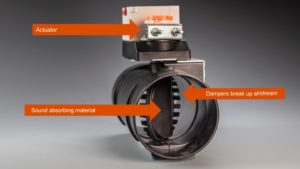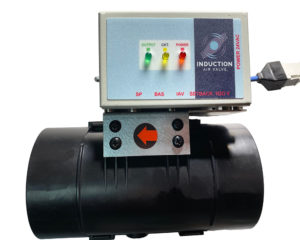
We’ve compiled these FAQs to answer your questions about IAVs and why they are a good business decision for your properties. If your question isn’t answered here, please submit it using our contact form.
The answers and examples given are based on New York City laws and building size and may differ for other locations.
Most buildings still rely on 50-year-old technology constant air perimeter induction units for 50% of heating and cooling. Modern HVAC design has embraced energy-efficient variable air volume (VAV) to control airflow. VAV reduces fan horsepower and the amount of outside air needed for heating and cooling.
ACES’ Induction Air Valve (IAV) is the only air control valve that converts constant air to VAV inside existing perimeter induction air units. No costly and disruptive replacement is necessary. The benefits are many: greater energy efficiency, reduced consumption, significant cost savings, and lower carbon emissions.
First and foremost, installing an IAV System is far more affordable. And second, installation is quick and not disruptive to tenants, which is especially important when the building has full occupancy.
Depending on the condition of your existing induction units, they may require replacement sooner than later. Installation of IAVs will extend the life of your existing units by making the entire system operate more efficiently. The instrumentation included with our system will show you how well your units are performing and which exposures may require replacement and when. Instead of replacing all the units, you may only have to replace those in areas where they are not meeting load requirements. Your IAV System is quickly and easily transferred to your new induction units.
For some buildings, replacement is a preferred option. ACES completed a partial replacement of 1,600 induction units for the Seagram Building at 375 Park Avenue with good results. The modern units draw less outside air, improve air circulation, and significantly cut energy usage, in this case saving $960,000 in energy costs the first year. But replacement is expensive, and for some cost-prohibitive.
Tests of IAV valve performance in six prominent New York City buildings confirmed reductions of air flow averaging 65% for winter heating and 25% for summer cooling. This translated into a 67% cut in kilowatt hours, an annual energy savings averaging $540,000 and eligibility for a $242,000 energy savings rebate.
 Costly, time-consuming and disruptive unit configuration is not required. Building staff can install a 4” diameter IAV in as little as 10 minutes, and installation can be done after business hours.
Costly, time-consuming and disruptive unit configuration is not required. Building staff can install a 4” diameter IAV in as little as 10 minutes, and installation can be done after business hours.
Yes. ACES offers two models to accommodate all buildings: pneumatic to connect to older thermostats and electronic to connect to both electronic and digital control systems.
ACES revolutionary IAV control valve is part of a complete instrumentation system that includes the IAV Controller™, the IAV Thermostat™, and the IAV Diagnostic Tool™. While optional, these proprietary and value-driven support instruments may be recommended for smooth operation and optimal performance, especially if the existing system is old.
 The valve is small with a 4” diameter that takes up only 4.5 inches of duct run when installed inside the existing unit inlet. The actuator receives and reacts to information from the thermostat and controller, opening or closing the airstream. A responsive damper inside the valve with multiple edge points breaks up the full airstream into mini airstreams, regulating air flow over the induction unit coil based on space requirements (VAV mode). Less air volume and a sound-absorbing core material substantially reduce noise from the induction unit.
The valve is small with a 4” diameter that takes up only 4.5 inches of duct run when installed inside the existing unit inlet. The actuator receives and reacts to information from the thermostat and controller, opening or closing the airstream. A responsive damper inside the valve with multiple edge points breaks up the full airstream into mini airstreams, regulating air flow over the induction unit coil based on space requirements (VAV mode). Less air volume and a sound-absorbing core material substantially reduce noise from the induction unit.
IAVs are also programmable office-by-office, saving 70% on energy for heating and cooling unoccupied offices and after work hours.
 The IAV Controller is a smart analog control device that uses the same electronics technology that put men in space and on the moon. It is field hardened, reliable and inexpensive.
The IAV Controller is a smart analog control device that uses the same electronics technology that put men in space and on the moon. It is field hardened, reliable and inexpensive.
The IAV Controller requires no programming, no expensive interfaces and is less than half the cost of direct digital controllers. It comes factory mounted to the IAV valve, is quickly connected with plugin connections during installation and ready to go in as little as 10 minutes.
The IAV Controller costs far less, typically costing under $700 each. This compares to Central BAS System induction units that can range between $2,500 and $3,500 each and Distributed (Smart Thermostats/Controllers or Actuators) units that can run $1,800 to $3,000 each.
Our controller features all industry standard input and output signals that are compatible with any Building Automation System (BAS) old or new. Just terminate these signals into your BAS system and program the points and you are ready to go. In addition, we will supply a custom termination board that will plug into your BAS without the need for time consuming manual terminations.
Tenants enjoy much quieter workspace free of rumbling and hissing. IAVs eliminate hot and cold spots while maintaining a constant temperature to one-tenth of one degree. As a selling feature, tenants and leasing professionals increasingly want energy-efficient and environment-friendly workspaces that already comply with impending lower carbon emission laws.
Induction are units are designed to use displacement ventilation, which can help reduce virus and pollutant contaminants. See Our Pandemic Guidance
Cost savings will differ for buildings in other U.S. locations.
Installing IAV valves makes fiscal sense for buildings operating constant volume perimeter induction systems. The outlay investment for the biggest buildings is quickly repaid in less than three years, and for some in little over one year.
This example is for a 1.3M sq. ft. building in New York City using 1,000 IAVs and 350 IAV Controllers
| Costs | |
|---|---|
| Costs for equipment and installation | $790,000 |
| ConEdison HVAC energy efficiency rebate | -$242,601 |
| Actual installation cost less rebate | $547,399* |
| Annual Out of-Pocket Savings | |
|---|---|
| 808,669 kWh savings@$0.22 | $177,907 |
| Steam savings | $341,491 |
| Summer cooling savings | $22,205 |
| Annual Energy Savings | $541,603 |
| Payback | |
|---|---|
| $541,603 | annual energy savings. |
| 1.01 | years to recoup installation investment. |
| $161,575 | annual savings for compliance with Local Law 97 carbon emissions, beginning in 2024. Over five years, this adds up to a $807,875 savings. |
Yes, converting constant air volume perimeter air induction units to VAV will significantly decrease energy use and subsequent carbon emissions. In addition to operating cost savings, when Local Law 97 goes into effect in 2024, buildings with carbon emissions exceeding 10% or more will receive steep fines.
Learn More